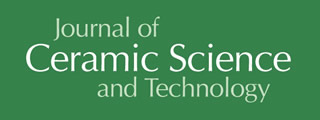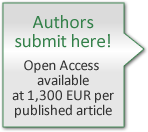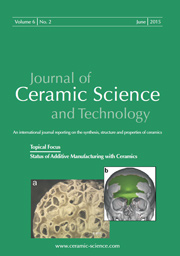Articles
All articles | Recent articles
Novel Ceramic Composites for Personalized 3D Structures
M. Ahlhelm, E. Schwarzer, U. Scheithauer, T. Moritz, A. Michaelis
Fraunhofer Institut für Keramische Technologien und Systeme (IKTS), Winterbergstraße 28, D-01277 Dresden, Germany
received November 2, 2016, received in revised form December 21, 2016, accepted January 25, 2017
Vol. 8, No. 1, Pages 91-100 DOI: 10.4416/JCST2016-00093
Abstract
The objective of the presented work is to further introduce a new hybrid shaping technique and develop novel porous, near-net shaped composite structures e.g. for personalized bone replacement materials.
The suspension-based additive manufacturing technique lithography-based ceramic manufacturing enables high structural resolution and the manufacturing of dense (> 99 %) ceramic components with high performance compared to other available AM techniques. On the other hand, freeze foaming offers the possibility to achieve mainly open porous and interconnected sponge-like structures that provably allow the ingrowth and differentiation of human mesenchymal stem cells (hMSCs). The near-net shaping feasibility of this foaming technique was used to foam the inner contours of complex LCM-manufactured ceramic shell structures in the shape of a femoral bone model. After a co-sintering step, they combine to structural composites with dense and porous features in one single 3D structure. This contribution therefore provides insides into a new line of technology comprising a new degree of freedom in personalization and application such as bone replacement materials.
![]() Download Full Article (PDF)
Download Full Article (PDF)
Keywords
Bioceramics, bone replacement materials, freeze foaming, LCM, hybrid shaping
References
1 Homa, J.: Rapid prototyping of high performance ceramics opens new opportunities for the CIM industry, Powder Inject. Molding Int., 6, [3], 65 – 68, (2012).
2 Moritz, T.: Light-weight green compact and molded article made of a ceramic and/or powder-metallurgical material, and the method for the production of thereof. German Patent DE102008000100, (2008).
3 Ahlhelm, M., Moritz, T.: Freeze Foaming: A promising approach for synthesizing cellular ceramic materials. In: Proceedings of the International Conference on Cellular Materials Cellmat, Dresden, 2010.
4 Ahlhelm, M., Günther, P., Scheithauer, U., Schwarzer, E., Günther, A., Slawik, T., Moritz, T., Michaelis, A.: Innovative and novel manufacturing methods of ceramics and metal-ceramic composites for biomedical applications, J. Eur. Ceram. Soc., 36, [12], 2883 – 2888, (2016).
5 Ahlhelm, M., Zybell, K., Gorjup, E., von Briesen, H., Moritz, T.: Freeze-foaming-a new approach to manufacture ceramic cellular structures allowing the ingrowth and differentiation of mesenchymal stem cells. In: Proceedings of the 13th International Meeting and Seminar on Ceramics, Cells and Tissues 13th CCT, Faenza, Italy, 2011.
6 Schwarzer, E., Ahlhelm, M., Scheithauer, U., Moritz, T., Michaelis, A.: Development of photo-curable ceramic suspensions usable for additive manufacturing combined with Freeze Foaming. In: Proceedings of the 3rd Fraunhofer Direct Digital Manufacturing Conference DDMC2016, Berlin, 2016.
7 Roy, D.M., Eysel, W., Dinger, D.: Hydrothermal synthesis of various carbonate containing calcium hydroxyapatites, Mater. Res. Bull., 9, 35 – 39, (1974).
8 Roy, D.M., Linnehan, S.K.: Hydroxyapatite formed from coral skeletal carbonate by hydrothermal exchange, Nature, 247, 220 – 222, (1974).
9 Sivakumar, M., Kumar, T.S.S., Shantha, K.L., Rao, K.P.: Development of hydroxyapatite derived from indian coral, Biomaterials, 17, 1709 – 1714, (1996).
10 Xu, Y., Wang, D., Yang, L., Tang, H.: Hydrothermal conversion of coral into hydroxyapatite, Mater. Charact., 47, 83 – 87, (2001).
11 Dan, N.: Synthesis of hierarchical materials, Trends Biotechnol., 18, 370 – 374, (2000).
12 Fratzl, P., Weinkamer, R.: Nature's hierarchical materials, Prog. Mater Sci., 52, 1263 – 1334, (2007).
13 Kusmanto, F., Walker, G., Gan, Q., Walsh, P., Buchanan, F., Dickson, G., McCaigue, M., Maggs, C., Dring, M.: Development of composite tissue scaffolds containing naturally sourced microporous hydroxyapatite, Chem. Eng. J., 139, 398 – 407, (2008).
14 Rocha, J., Lemos, A., Agathopoulos, S., Kannan, S., Valerio, P., Ferreira, J.: Hydrothermal growth of hydroxyapatite scaffolds from aragonitic cuttlefish bones, J. Biomed. Mater. Res., Part A, 77A, 160 – 168, (2006).
15 Vecchio, K., Zhang, X., Massie, J., Wang, M., Kim, C.: Conversion of bulk seashells to biocompatible hydroxyapatite for bone implants, Acta Biomater., 3, 910 – 918, (2007).
16 Vecchio, K., Zhang, X., Massie, J., Wang, M., Kim, C.: Conversion of sea urchin spines to Mg-substituted tricalcium phosphate for bone implants, Acta Biomater., 3, 785 – 793, (2007).
17 Walsh, P., Buchanan, F., Dring, M., Maggs, C., Bell, S., Walker, G.: Low-pressure synthesis and characterisation of hydroxyapatite derived from mineralise red algae, Chem. Eng. J., 137, 173 – 179, (2008).
18 Wu, S.L., Liu, X.M., Hu, T., Chu, P.K., Ho, J.P.Y., Chan, Y.L., Yeung, K.W.K., Chu, C.L., Hung, T.F., Huo, K.F., Chung, C.Y., Lu, W.W., Cheung, K.M.C., Luk, K.D.K.: A biomimetic hierarchical scaffold: Natural growth of nanotitanates on three-dimensional microporous Ti-based metals, Nano Lett., 8, 3803 – 3808, (2008).
19 Zhang, X., Vecchio, K.S.: Creation of dense hydroxyapatite (synthetic bone) by hydrothermal conversion of seashells, Mater. Sci. Eng. C-Biomimetic Supramol. Syst., 26, 1445 – 1450, (2006).
20 Ruffini, A., Sprio, S., Tampieri, A.:Study of the hydrothermal transformation of wood-derived calcium carbonate into 3D hierarchically organized hydroxyapatite, Chem. Eng. J., 217, 150 – 158 (2013).
21 Ahlhelm, M., Moritz, T.: Synthetic bone substitute material and method for producing the same. European Patent EP2682137A3, (2013).
22 Ahlhelm, M., Moritz, T.: Production of a biocompatible hydroxyapatite-ZrO2 hybrid form with the method of freeze-foaming, (in German), in Schriftenreihe Werkstoffe und Werkstofftechnische Anwendungen 41, Hrsg., B. Wielage, Chemnitz: Deutsche Gesellschaft für Materialkunde e.V. DGM, 2011.
23 Ahlhelm, M., Gorjup, E., von Briesen, H., Moritz, T., Michaelis, A.: Freeze-foaming – A promising approach to manufacture strength enhanced ceramic cellular structures allowing the ingrowth and differentiation of human mesenchymal stem cells, in: Proceedings of MiMe-Materials in Medicine, International Conference 1st edition MIME, Faenza, Italy, 2013.
24 Ahlhelm, M.: Freeze Foams – Development of cellular structures for various applications, (in German), in Schriftenreihe Kompetenzen in Keramik, Band 32, Hrsg.: Fraunhofer IKTS, Dresden; Alexander Michaelis, Fraunhofer Verlag, ISBN 978 – 3-8396 – 0977 – 4, 2016.
25 Ahlhelm, M., Fruhstorfer, J., Moritz, T., Michaelis, A.: Producing lightweight refractory bricks with the direct freeze foaming method, (in German), Keramische Zeitschrift, 6, [63], 405 – 409, (2011).
26 Ahlhelm, M., Fruhstorfer, J., Moritz, T., Michaelis, A.: The manufacturing of lightweight refractories by direct freeze foaming technique, Interceram, 6, [60], 394 – 399, (2011).
27 Günther, P.: Development of porosity-graded structures on the basis of zirconium dioxide with the combination of additive manufacturing and direct freeze foaming, (in German), Master's Thesis, Hochschule Koblenz/Fraunhofer IKTS Dresden, (2015).
Copyright
Göller Verlag GmbH


